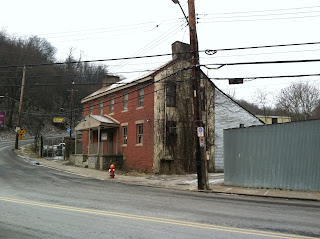In a gritty corner of the city known as the "West End Valley" sits an isolated urban village containing perhaps the oldest building west of the Allegheny Mountains. The structure's cornerstone lays claim to a construction date of 1756, and the sign on the now-defunct bar also boasts "Established 1756." Just a refresher in local history: General Edward Braddock tried and failed to capture Fort Duquesne (Pittsburgh) from the French in 1755. General John Forbes succeeded in 1757 and founded the British outposts of Fort Pitt and Pittsburgh. It seems almost inconceivable that a two-story stone inn was constructed just west of the French fort in the interim between the two military campaigns, at the very beginning of the French and Indian War. And yet, if this old house is not lying about its age, then it is a full eight years older than the Fort Pitt Blockhouse, which carries the official designation of "oldest building in the city" and region. The old inn stands derelict with broken windows and crumbling walls.
In the upper photo, notice that the inn sits at the corners of two of the oldest roads in the region: Greentree Road and Woodville Road. There was a prominent early inn whose name appears frequently in old histories of the city: "The Sign of the Green Tree." I don't know if this building was the once-famous Green Tree Inn, but it wouldn't surprise me. After all, it stands at the head of Greentree Road, on the edge of the Borough of Greentree. As for Woodville Road, it is little more than a ghost of its former self. Industrial development has obliterated Woodville Road, all except for the few scant meters shown here. My guess is that Woodville Road ran from this spot--an inn on the westernmost reaches of the British Empire--down to Woodville Plantation, another of the oldest buildings in the region. Even if the Old Stone Tavern was not constructed in 1756, it is certainly a product of the 18th century. Firm records of it appear in the annals of the Whiskey Rebellion, which took place in the 1790s. Tragically, here it sits on a busy, ugly corner, empty and forlorn, returning to the elements. I've said it many a time: Pittsburgh is an unsentimental city. Historic significance and beauty will do nothing to get a place protected and preserved.
Some smart-ass painted the old stones red, probably in an effort to protect them from erosion. Who owns this place? Can nothing be done to save it? It's true that the chimneys lean a little inward. I wonder if structural problems make the place unusable.



https://www.youtube.com/watch?v=CtbY57yYYIc
ReplyDeleteA group is working on this project, http://postfriendstrust.org, and welcomes your membership. Thank you for your interest!
ReplyDeleteThere is a datestone on the side of the building saying "Built A.D. 1752". This must be investigated further but for now it is circa 1782. Pittsburgh's Old Stone Tavern Friends Trust, Inc. has been organized. See our website: postfriendstrust.org/ A ledger has also been found for this building that is fascinating. All are welcome to join us.
ReplyDeleteThis comment has been removed by the author.
ReplyDeleteThe owner is Harris Masonry, right next door to the building.
ReplyDelete